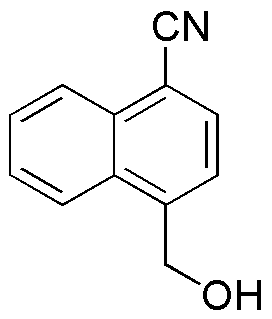4-(Hydroxymethyl)naphthalene-1-carbonitrile is widely utilized in research focused on:
- Pharmaceutical Development: This compound serves as a key intermediate in the synthesis of various pharmaceuticals, enhancing the efficiency of drug discovery processes.
- Organic Synthesis: It is employed in organic synthesis for creating complex molecules, particularly in the development of new materials and chemicals.
- Polymer Chemistry: The compound is used in the formulation of specialty polymers, providing unique properties such as improved thermal stability and mechanical strength.
- Fluorescent Dyes: It can be utilized in the production of fluorescent dyes, which are essential in biological imaging and diagnostics, offering high sensitivity and specificity.
- Research in Material Science: The compound is explored for its potential applications in nanotechnology and advanced materials, contributing to innovations in electronics and coatings.
General Information
Properties
Safety and Regulations
Applications
4-(Hydroxymethyl)naphthalene-1-carbonitrile is widely utilized in research focused on:
- Pharmaceutical Development: This compound serves as a key intermediate in the synthesis of various pharmaceuticals, enhancing the efficiency of drug discovery processes.
- Organic Synthesis: It is employed in organic synthesis for creating complex molecules, particularly in the development of new materials and chemicals.
- Polymer Chemistry: The compound is used in the formulation of specialty polymers, providing unique properties such as improved thermal stability and mechanical strength.
- Fluorescent Dyes: It can be utilized in the production of fluorescent dyes, which are essential in biological imaging and diagnostics, offering high sensitivity and specificity.
- Research in Material Science: The compound is explored for its potential applications in nanotechnology and advanced materials, contributing to innovations in electronics and coatings.
Documents
Safety Data Sheets (SDS)
The SDS provides comprehensive safety information on handling, storage, and disposal of the product.
Product Specification (PS)
The PS provides a comprehensive breakdown of the product’s properties, including chemical composition, physical state, purity, and storage requirements. It also details acceptable quality ranges and the product's intended applications.
Certificates of Analysis (COA)
Search for Certificates of Analysis (COA) by entering the products Lot Number. Lot and Batch Numbers can be found on a product’s label following the words ‘Lot’ or ‘Batch’.
*Catalog Number
*Lot Number
Certificates Of Origin (COO)
This COO confirms the country where the product was manufactured, and also details the materials and components used in it and whether it is derived from natural, synthetic, or other specific sources. This certificate may be required for customs, trade, and regulatory compliance.
*Catalog Number
*Lot Number
Safety Data Sheets (SDS)
The SDS provides comprehensive safety information on handling, storage, and disposal of the product.
DownloadProduct Specification (PS)
The PS provides a comprehensive breakdown of the product’s properties, including chemical composition, physical state, purity, and storage requirements. It also details acceptable quality ranges and the product's intended applications.
DownloadCertificates of Analysis (COA)
Search for Certificates of Analysis (COA) by entering the products Lot Number. Lot and Batch Numbers can be found on a product’s label following the words ‘Lot’ or ‘Batch’.
*Catalog Number
*Lot Number
Certificates Of Origin (COO)
This COO confirms the country where the product was manufactured, and also details the materials and components used in it and whether it is derived from natural, synthetic, or other specific sources. This certificate may be required for customs, trade, and regulatory compliance.


